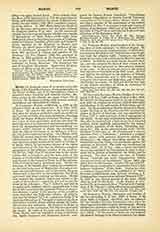

Mariannhill, CONGREGATION OF THE MISSIONARIES OF.—Mariannhill is located in Natal, near Pinetown, 15 miles from Durban, and 56 from Pietermaritzburg. In 1882 the Rev. Francis Pfanner, then prior of the Trappist (Reformed Cistercian) Monastery of Maria-stern (Bosnia), at the invitation of the late Bishop Ricards, and with the consent of the general chapter of that branch of the order called the Congregation of De Rance, volunteered to establish a monastery in Cape Colony, in order to try to adapt their rule to the missionary life. He landed at Port Elizabeth with thirty-one companions in July, 1880, and settled in a place he called Dunbrody, after an old Irish monastery. This he had to abandon in 1882; and at the solicitation of the late Bishop Jolivet, O.M.I., transferred his community to Mariannhill. Upon arrival there he set to work with indefatigable energy in the missionary field, and was blessed with such success that in 1885 Mariannhill was erected into an abbey, and Father Pfanner was unanimously elected its first abbot, receiving the abbatial blessing on the third anniversary of the founding of the monastery, December 27, 1885. The same year Abbot Pfanner had started a branch of missionary sisters called “Sisters of the Precious Blood” to take charge of the native children and women; this congregation flourished abundantly, and was approved by Rome in 1907.
Mariannhill was too restricted for the zeal of Abbot Pfanner, so in the course of a few years, he founded seven mission stations, scattered over Natal, from Transvaal (Ratschitz) to Cape Colony (Lourdes) in Griqualand. Each of these stations had a small community of monks, and another of sisters, with church, school, etc., according to the needs of the natives. In 1892 Abbot Pfanner, who was then sixty-seven years of age, resigned and retired to Emmaus, one of the stations, where he died on May 24, 1909. He was immediately succeeded by Dom Amandus Schoelzig as administrator, and in 1894 as abbot. Under his wise administration nine stations were founded in Natal and Cape Colony, and two houses in German East Africa. Abbot Amandus died in January, 1900, a martyr to the great work and its many cares. In September of the same year he was succeeded by Abbot Gerard Wolpert, who had spent the greater part of his missionary life at the Czenstochau Station. He founded a station in Mashonaland, Rhodesia, and two more in Natal, so that his activity was divided between German East Africa, Rhodesia, Natal and Cape Colony. This, however, was too much for his strength; his health gave way, and being anxious to return to his mission life at Czenstochau, he resigned his position in 1904.
During the general chapter of the order held that year at Citeaux, the Rt. Rev. Edmond M. Obrecht, Abbot of the Abbey of Gethsemani, U.S.A., was appointed, with the approbation of the Holy See, Administrator of Mariannhill. His principal labor was to enquire into the adaptability of the Cistercian to the missionary life; after three years of work in Africa the Abbot of Gethsemani submitted his report to Rome and the general chapter, from which it was decided that Mariannhill should become an independent congregation, as otherwise either the monastic observances or the missionary labor had to suffer. Consequently Propaganda delegated Rt. Rev. Bishop Miller, M.I., Vicar-Apostolic of Transvaal, to arrange for such independence, according to the wishes of the Reformed Cistercians, and the members of Mariannhill. Finally the Congregation of Regulars, on February 2, 1909, issued a decree separating Mariannhill from the Order of Reformed Cistercians, forming of it the “Congregation of the Mariannhill Missionaries” and erecting their church into a Collegiate Church, under the guidance of a provost. The members of the congregation take simple, but perpetual, vows; and are exempt from the jurisdiction of the Ordinary of the diocese. They at present number about 60 priests, with 260 choir-religious and lay-brothers. From its foundation until January 1 1910, nearly 20,000 persons, the greater number adults, have been baptized in the 55 churches and chapels scattered throughout the 26 missions and stations.
EDMOND M. OBRECHT

